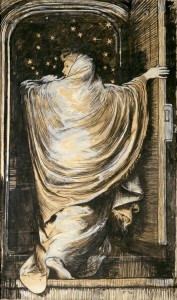During his study of the human psyche, Sigmund Freud concluded that it was divided into three separate parts: The Id, the Ego, and the Superego. It is quite common for these parts of the mind to come into conflict, and while it is often an internal struggle, we are able to observe these struggles through first person narration. In The Woman in White we are able to see this struggle through the compilation and narration of Walter Hartright.
On the first page of the novel, Walter prevails upon the reader to consider the tale he is telling as a judge might consider a case. What he is trying to prove, we do not yet know, but we are led to believe that he is endeavoring to provide the most accurate depiction of what occurred as possible. Indeed, Walter says at the bottom of that first page,
Thus, the story here presented will be told by more than one pen….with the same object…to present the truth always in its most direct and most intelligible aspect; and to trace the course of one complete series of events. (Collins, 9)
This also suggests that the individuals Walter is including are to be considered reliable in their accounts of events.
By the conclusion of the novel, however, the validity of these opening lines is called into question. At the end of the pages included of Marian’s diary is a “Postscript by a Sincere Friend” who on later pages we find out to be Count Fosco. The contents of Marian’s diary are extremely condemning to the Count and Sir Percival, so it is not outside of reason to assume that he potentially altered some of the contents of her writing, rendering it unreliable and thus unusable in the constraints of a court of law. Also, Walter tells us as we near the end of the tale that he has changed all of the names of the individuals involved in the book to protect their privacy. If he has changed one thing about the tale, is it not possible, or even probable, that he has changed more as well?
I believe that it is very likely that he did, and that the inclusion of the damning material are manifestations of his conflicting Ego and Superego. When the Ego and Superego come into conflict, they battle over what is possibly attainable and whether it is right to attain it or not (Conflict Chart, The Victorian Web). What we can assume Walter desires is the rights to Limmeridge house, and that he is providing this account as a means of acquiring it. This is a manifestation of his Ego. However, his Superego intervenes, knowing his claim is false, and that pretending it is not is wrong. Thus, Walter’s Superego prompts him to include the information that would prove him false, because it is the right thing to do.
